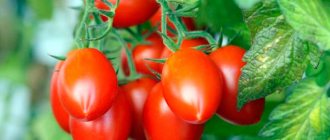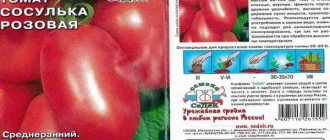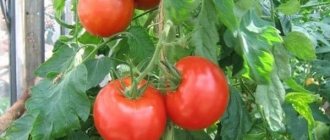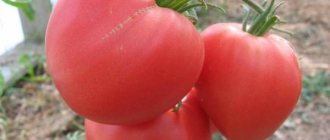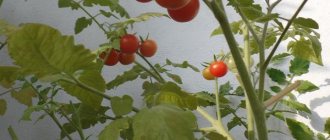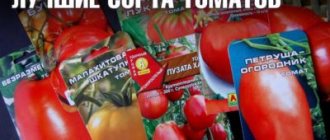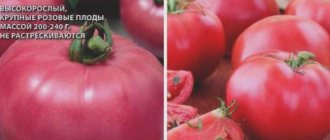Sicilian pepper is a medium-late tomato with unlimited growth, intended for greenhouses. It must be tied to a strong support. In return, the tomato will reward you with a large number of tasty fruits of unusual shape with excellent taste.
| Height | Landing location | Ripening time | Fruit color | Fruit size | Origin | Fruit shape |
| Tall | Greenhouse | Mid-season | Reds | Large | Variety | Heart-shaped |
Description of tomato Sicilian pepper advantages and characteristics
The author of the cultivar is the breeding department (Moscow).
Entered into the register in 2015. Recommended for all regions, can be grown in private plots, film and polycarbonate greenhouses without heating. The purpose of the fruit is salad. The first harvest is harvested 120 days after germination. Tomatoes ripen on simple inflorescences surrounded by medium-sized dark green leaves. The shape of the fruit is heart-shaped.
The tomatoes are large, with an average weight of more than 200 g. There are faint ribs on the surface. The pulp is medium dense, there are 3-4 seed chambers. Unripe fruits are dark green and turn red when ripe.
The Sicilian pepper variety has an excellent taste.
Bushes can grow down to 2 meters in height. From one bush you can collect up to 5 kg of ripe tomatoes. The ovaries are formed in clusters, 4 tomatoes in each. The shape of the fruit is pepper-shaped, the mesophyll is juicy. When fully ripe, tomatoes become red in color. The average conglomerate of one fruit is 150 grams.
Tomatoes are perfect for fresh consumption, for all types of preparations and for freezing.
Features of cultivation and storage
The seeds are sown in March. The soil is first calcined in the oven to get rid of dangerous fungi and harmful insects. Movra should be treated with a solution of potassium permanganate. This will help to get quick and friendly shoots. Movra is placed in the ground to a depth of 1.5 cm. After sowing, the boxes are covered with film and placed in a warm and sunny space.
We invite you to familiarize yourself with: Phosphorus-potassium fertilizer for tomatoes
For 10-12 days before planting in a permanent place, seedlings must be hardened off. Every day the containers are taken outside, increasing the duration of stay from 20 minutes to 2 hours.
Immediately before planting, it is not forbidden to leave the seedlings in the fresh air overnight. Planting of seedlings in gaping soil occurs in mid-May at the age of 50-55 days. Stepchildren must be removed in time.
Seeds are sown for seedlings in the second half of March. When the first real leaf unfolds, you can pick. Seedlings are planted in a greenhouse at the age of 50-55 days according to a 40 by 50 cm pattern.
The vines are formed into one stem, removing all side shoots.
Early maturing / Tall
User rating: 4/5
Mid-season / Tall
User rating: 4/5
Early maturing / Tall
Rules for planting and caring for plants
- Eggs should be watered regularly. The soil should not be over-moistened; this may adversely affect the taste of the fruit. Watering should be done once a week if there is no rain.
- During the growing season, during flowering and with the onset of fruiting, the bushes should be fed with organic and mineral fertilizers.
- It is imperative to hill up the bushes, loosen the soil and remove weeds.
- For preventive purposes, plants need to be sprayed with special preparations against pests and fungi.
The description would be insufficient without mentioning the rich, bright red hue of the fruit, the taste of which is literally felt through the smooth skin.
Tomatoes thrive in greenhouse conditions and produce excellent yields on unprotected soil, subject to agrotechnical requirements and favorable weather.
Any housewife who has planted a “princess” knows that the vegetable does not tolerate crowding. On 1 m² of land there should be no more than 4 bushes with 1 stem and no more than 3 bushes with 2 branches. For maximum fruiting, 2 stems should be left.
We invite you to familiarize yourself with: Savoy cabbage, cultivation and care of varieties
Tomatoes should be planted in well-ventilated areas. Where trees are close, the plant cannot realize its potential.
The ripening period on average ranges from 100 to 110 days. With proper care, the yield from 1 bush reaches 13 kg per season. The weight of 1 vegetable can range from 150 to 250 g.
A tomato is not susceptible to rapid rotting if there is no source of infection nearby. The fruits tolerate transportation well. If the weather changes, fruiting practically remains at the same level.
Reviews from experts and amateurs say that “princess” is one of the best large-fruited hybrid tomatoes.
It does not require special care - both at the stage of seedling germination and during the active growing season. Difficulties can arise only due to the climatic characteristics of mid-latitudes.
In this case, the gardener has one answer: “I grow the variety only in a greenhouse.”
Features of cultivation and storage
The seeds are sown in March. The soil is first calcined in the oven to get rid of dangerous fungi and harmful insects. Movra should be treated with a solution of potassium permanganate. This will help to get quick and friendly shoots. Movra is placed in the ground to a depth of 1.5 cm. After sowing, the boxes are covered with film and placed in a warm and sunny space.
We suggest you read: Recipe for cockroaches with boric acid.
For 10-12 days before planting in a permanent place, seedlings must be hardened off. Every day the containers are taken outside, increasing the duration of stay from 20 minutes to 2 hours. Immediately before planting, it is not forbidden to leave the seedlings in the fresh air overnight. Planting of seedlings in gaping soil occurs in mid-May at the age of 50-55 days. Stepchildren must be removed in time. To obtain a good harvest and healthy, strong fruits, you must follow the care recommendations.
Seeds are sown for seedlings in the second half of March. When the first real leaf unfolds, you can pick. Seedlings are planted in a greenhouse at the age of 50-55 days according to a 40 by 50 cm pattern.
The vines are formed into one stem, removing all side shoots.
Early maturing / Tall
User rating: 4/5
Mid-season / Tall
User rating: 4/5
Early maturing / Tall
How to care for a tomato in open and closed ground
Growing seedlings is one of the most important stages of growing tomatoes at home.
The optimal time for sowing seeds is the second half of March.
Description of growing planting material:
- Soak the seeds in a solution of potassium permanganate for 30 minutes;
- Pour substrate into the boxes. The soil temperature should be more than +15 degrees;
- Make furrows in the ground and sow seeds. Water;
- Cover the containers with clear glass. When sprouts appear, remove the glass;
- When the bushes grow, plant them in separate containers;
- 2 weeks before planting in a permanent place, seedlings should begin to be hardened off. The seedlings are taken outside for half an hour every day. This is how seedlings quickly adapt to new conditions;
- Bushes are planted in beds at the end of May.
Hybrid Ekaterina is recommended to be planted in open sunny areas. The bushes do not tolerate stagnant rainwater and shade. It is preferable to choose fertile soils. If the soil does not have enough nutrients, you can add organic or mineral fertilizers before planting the bushes.
A month after planting the seedlings, they need to be hilled up. This will allow the root system to grow better. After 14 days, hilling must be repeated again.
Another effective way to increase yield is to tap the stems with a wooden stick. Tapping is necessary so that the bushes are better pollinated. Thanks to this action, tomatoes ripen 8 days earlier.
About three times a week, the bushes are tapped with a light wooden stick. If the weather is sunny, then one tap will be enough. If it's cloudy, then 2-3.
Quick and sudden movements can cause all the pollen to fall off. When the ovaries form on the first three inflorescences, the procedure can be stopped. You can also spray the bushes with a solution of boric acid. Spraying is carried out during the period of active formation of ovaries and fruits.
Tomato Sicilian pepper - description and characteristics of the variety
Vegetables occupy an important place in human nutrition. Gardeners spend a lot of time growing different crops, and back gardens are especially popular.
The Sicilian pepper variety is a well-known type of tomato. Mid-ripening eggs are distinguished by high taste characteristics and are intended for cultivation in open ground or - or under temporary film covers.
Bushes can grow down to 2 meters in height. From one bush you can collect up to 5 kg of ripe tomatoes. The ovaries are formed in clusters, 4 tomatoes in each. The shape of the fruit is pepper-shaped, the mesophyll is juicy. When fully ripe, tomatoes become red in color. The average conglomerate of one fruit is 150 grams.
Tomatoes are perfect for fresh consumption, for all types of preparations and for freezing.
Advantages and disadvantages
People who grow this variety note the following positive features:
- Good resistance to dangerous diseases and pests.
- High tomato yield even under unfavorable conditions.
- Excellent taste.
- Duration of fresh storage.
The only drawback is poor vulnerability to cold.
Growing rules
The seeds are sown in March. The soil is first calcined in the oven to get rid of dangerous fungi and harmful insects. Movra should be treated with a solution of potassium permanganate. This will help to get quick and friendly shoots.
Movra is placed in the ground to a depth of 1.5 cm. After sowing, the boxes are covered with film and placed in a warm and sunny space. Seedlings need to be regularly watered with warm, settled water and complex fertilizers applied.
As soon as 1 true leaf appears, the plants are planted in separate containers.
For 10-12 days before planting in a permanent place, seedlings must be hardened off. Every day the containers are taken outside, increasing the duration of stay from 20 minutes to 2 hours.
Immediately before planting, it is not forbidden to leave the seedlings in the fresh air overnight. Planting of seedlings in gaping soil occurs in mid-May at the age of 50-55 days. Stepchildren must be removed in time.
Care instructions
- Eggs should be watered regularly. The soil should not be over-moistened; this may adversely affect the taste of the fruit. Watering should be done once a week if there is no rain.
- During the growing season, during flowering and with the onset of fruiting, the bushes should be fed with organic and mineral fertilizers.
- It is imperative to hill up the bushes, loosen the soil and remove weeds.
- For preventive purposes, plants need to be sprayed with special preparations against pests and fungi.
Summer residents and farmers speak positively about the Sicilian pepper variety. To achieve maximum results in harvesting, you must adhere to agricultural cultivation techniques, and in addition follow the rules of care.
- Valentina Fedorovna, 62 years old:
I saw this variety in my neighbors’ garden. I decided to cut my own tomatoes this year. I was pleased with the result. The tomatoes are dense, bright red in color and have an excellent taste. For the winter I prepared tomato juice, lecho, ketchup and marinated it. The bushes grow tall, so I tied them to wooden sticks. I always tore off the stepsons, loosened the ground and weeded. She reaped a high-quality harvest. - Peter D., 70 years old:
I read on the Internet about the Sicilian pepper variety, and decided to take the risk of planting it on my plot. I picked 4 kg of ripe fruits from each bush nearby. The variety does not require increased care. Please strictly follow the simple recommendations described in the instructions. Tomatoes keep well fresh. Hardly once during the summer did I apply complex fertilizers and cut off the stepsons. Like, just when the cold season arrived, I picked unripe tomatoes, all of them ripened at home. I advise all summer residents to try this type of tomato. - Serge, 48 years old:
This year I decided to plant eggs of the Sicilian pepper variety. The fruits grew almost the same shape; when fully ripened, they acquired a red color. True, the yield of the variety is far from rich enough. We managed to collect only 2-3 kg from the bush. Next year I will try to fully fertilize and water. This summer turned out to be dry, maybe the plants did not have enough moisture, which is why there was such a poor harvest result. I especially liked the taste of marinated tomatoes of this variety. I recommend growing Sicilian pepper to everyone who loves delicious fruits.
Reviews from gardeners
The tomato variety “Sicilian pepper” is well known to many summer residents. We invite you to read the most interesting opinions about him.
- I read reviews about the good yield of “Sicilian pepper” and planted it in my dacha. I can’t say that the harvest was high. I don’t know why, but I couldn’t collect more than 2 kg from a bush. Maybe some mistake in care, although I seem to be an experienced gardener. (Olga Yurievna, Petrozavodsk)
- I carefully studied the materiel before planting the variety. I read the description, all the characteristics. To be honest, I expected more from tomatoes. They turned out tough and a little viscous in taste. But it is worth noting that they are excellent when marinated. (Alexander, Zelenodolsk)
- I always approach growing tomatoes responsibly. I do everything according to the rules, according to the instructions. This tactic never fails. As for the “Sicilian pepper,” timely loosening of the soil and removal of weeds is important for its good yield. And don’t forget about mineral fertilizers. (Farida Zakiryanovna, Aksubaevo village, Tatarstan)
- These are simply magical tomatoes! That time when the whole family is delighted. They are tasty and juicy. Suitable for salads, tomato juices and sauces, rolling into jars. You can also make dried ones. This variety is a real find for the housewife. (Olga Valerievna, Sochi)
- The problem with all indeterminates is that they are difficult to control in the greenhouse. They can grow to unrealistic sizes. And my “Sicilian pepper” has grown so much. We entered the greenhouse as if we were entering a fantastic forest. And then I read that it is generally only suitable for open ground. Gee. (Valentina, Kirov)
- This wonderful tomato was recommended to me by a neighbor. It does not require complex care and produces a good harvest. If you are not lazy, you can achieve significant success in growing Sicilian pepper. I got 3.5 - 4 kg per bush. The fruits are smooth and shiny, like from a store window. (Rosa, Naberezhnye Chelny)
See also
Description of the tomato variety Dacosta Portuguese and its characteristicsRead
Tomato verlioka: characteristics and description of the variety. Growing and caring for verlioca (video + 110 photos)
It is important for gardeners to choose the right variety with the desired characteristics. To obtain a large harvest, it is important to take into account many factors: the number of sunny days per year, humidity level, temperature, soil, etc.
A unique variety has been developed - Verlioka tomatoes, which produces up to 20 kg of juicy fruits per 1 sq. m.
Even an inexperienced gardener can grow unpretentious tomatoes.
Characteristics and description of the variety
The Verlioka tomato is a hybrid with early ripening fruits. It is recommended to plant 3 bushes per 1 square meter. m. The branches grow up to 2 m, so a garter is necessary.
Dense fruits, each 80-100 grams have a dark red color. It grows well in a greenhouse, or under film, as difficulties are possible in open areas.
Very tasty sweet fruits with a slight sourness. Tomatoes contain high levels of beta-carotene, as well as sugars and amino acids.
Description of the advantages of Verlioka tomatoes:
- good harvest;
- easy care;
- excellent taste (for salads and canning);
- resistance to any diseases;
Disadvantages of the variety:
- the need to garter bushes;
- feeding is required.
Reference! Modern breeders have developed a new variety for greenhouses, “Verlioka Plus”.
Basic rules for planting verlioca
Description of preparing tomato seedlings is an important stage in the development of the plant. When planting shoots, you must strictly follow the instructions:
A good solution would be to choose a place where they used to grow: cucumbers, cabbage, as well as carrots, all legumes, zucchini or greens.
Badly affect the taste: pepper, tobacco, potatoes, even physalis or eggplant.
Be sure to check the soil; if it is acidic, this will dramatically reduce the seedling’s resistance to diseases and fungi. It is necessary to make the soil loose so that air can penetrate well. A fertile and nutritious environment is required.
For the 1st bush, allocate a space of 40:50 cm.
Important! Experts do not recommend fertilizing with fresh manure in the spring, so as not to provoke active growth of leaves rather than tomatoes.
Rules for the greenhouse variety Verlioka
Let's look at the recommendations of experts:
When transferring seedlings to the ground, each bush requires good watering (5 liters of water per 1 bush). Then mulching is carried out to retain moisture and prevent weeds.
The Verlioka variety calmly tolerates fluctuations in humidity, but it is better to stick to humidity: in the greenhouse 40-60%, and in the soil -70-80%.
Watering should be carried out only in the evening, the water should be warm and the soil should be visibly dry. Ideal drip irrigation.
Fertilizing with complex fertilizers, such as “Fertility” or “Ideal”.
Verlioka is a variety that is resistant to various diseases. But for prevention, it is recommended to treat the greens with special means.
The bushes are tall, so they require shaping and pinching.
Important! In April, Verlioka tomatoes can be planted only in the southern regions. In the middle zone, even in a greenhouse it is necessary to plant in the last ten days of May, when it is warm
Garter bushes
It will be problematic to grow an excellent harvest if you do not tie up 2-meter stems and do not shoot. Let’s look in detail at how to correctly form a Verlioka tomato bush:
It should be formed into 1-2 stems, be sure to pinch as the bush grows. This will save space in the greenhouse for planting more plants.
It is advisable to leave 2 inflorescences on 1 stem. This will allow the bush to grow faster and give a better harvest.
You need to pay attention so that the inflorescences are not located too low above the ground
Leave 2 leaves near the inflorescences. Stem staking is required.
Important! For greater growth, you can move the growth point to the side of the shoot. Please note that limiting the growth of the bush will sharply shorten the fruiting period
Experienced gardeners love and enjoy growing the early ripening variety “Verlioka”. The popularity is explained by the good harvest, disease resistance and unpretentiousness of the plants.
By following simple advice from professionals, everyone can grow delicious tomatoes.
Tomato Batyanya characteristics and description of the variety. Advantages and disadvantages of the variety
Tomato lovers are increasingly interested in their varieties and varieties, choosing the best option for themselves. Tomatoes are very tasty and healthy vegetables that can also be prepared for the winter. As for the Batyanya variety, it was bred so that gardeners would have something to grow in the harsh climatic conditions of Siberia. The most optimal planting will be in the central and southern regions.
Bushes are 180 – 210 cm in height, so they need to be tied up
Particular attention should be paid to pinching: to obtain the best harvest, it will be enough to leave 1 - 2 trunks
Don’t forget about feeding the plant; you can use fertilizers of both mineral and organic origin. Batyanya has a high level of resistance to late blight, but the bush must be protected from other diseases.
Tomato Batyanya:
- resistant to low temperatures and even frost;
- can be grown both in open ground and in greenhouse conditions;
- early ripening;
- requires periodic tying and pinching;
- endowed with a high level of resistance to late blight;
- characterized by a high level of productivity;
- tall;
- requires periodic fertilization;
- It has a fleshy consistency, the fruits are pink in color with a sweetish taste.
- high rates of transportability;
- resistance to frost and drought;
- possibility of propagation at home using seeds;
- high yield rates;
- slight foliage;
- resistance to late blight;
- early ripeness.
- low seed germination;
- the appearance of numerous stepsons (needs to be pruned regularly);
- high sensitivity to moisture (fruits rot);
- Because of the heavy fruits, the shoots often break (this can be avoided by tying each cluster individually).
The variety has more advantages than disadvantages. This:
- early maturation;
- large fruits;
- high transportability;
- unpretentiousness to growing conditions;
- resistance to late blight;
- high yield rates;
- good taste characteristics.
The disadvantages include the need for staking tomatoes.
The Batyanya tomato has a number of positive qualities and is in demand among farmers and gardeners. Advantages of the variety:
- early fruit ripening;
- not picky about the soil, can grow even on clay soils;
- the entire fruiting period produces large, high-quality tomatoes;
- versatility in using tomatoes;
- natural resistance to adverse weather and typical nightshade pathologies;
- tomatoes do not crack or get damaged during transportation;
- long fruiting period;
- Long-term storage of up to three weeks is possible.
In addition to the positive aspects, the Batyanya tomato also has disadvantages:
- at high humidity it is prone to rotting;
- low seed germination;
- taste properties are weakly expressed, there is no aroma;
- Frequent tying of fragile hands is required;
- an excessive amount of excess greenery, as a result of frequent pinching.
Recommendations from gardeners
The Sicilian pepper tomato variety, reviews of which indicate excellent taste and the ability to grow in any conditions, is popular among tomato connoisseurs.
Read also: Shelf life of beeswax
Inna Zhuravleva, 46 years old, Sochi: “I am passionate about growing tomatoes, so I often choose new varieties. The description of the Sicilian pepper caught my attention. Tomatoes were planted in open ground. The plant really has unlimited growth; you need to remove excess shoots. The main thing is that the bushes did not get sick and bore fruit until the first frost. The tomatoes are bright, with an intense red color, very tasty.”
Valentina Egorova, 51 years old, Belaya Kholunitsa: “The Sicilian pepper tomatoes came from a friend. She gave ripe tomatoes for seeds and shared growing tips. I planted the bushes in the greenhouse and in the garden. In the greenhouse we managed to harvest the first harvest from the bush a little faster. Fruits from the garden turned out to be more fragrant. There’s only one drawback: at the end of the season, when it gets cool outside, the growth and ripening of tomatoes slows down.”
Alexander Evdokimov, 61 years old, Nizhnekamsk: “I read the characteristics of the Sicilian pepper variety in one of the magazines and decided to grow it in a greenhouse. A good tomato, the plant does not require special attention. Without complicated care, we managed to remove 3.5-4 kg of bright red fruits with an attractive appearance and smooth surface from the bush. I especially liked the sun-dried tomatoes.”
Antonika Lavrova, 49 years old, Krasnodar: “I grew Sicilian pepper from seeds. I made seedlings myself, and transplanted the bushes under film. During the season they grew so much that the greenhouse seemed like an impenetrable jungle. Of course, this happened as a result of neglecting care recommendations. The bush must be formed into one stem and the excess stepsons must be removed. Next season I will definitely take this fact into account. Therefore, the yield was low; I removed about 3 kg of tomatoes from the bush. Brightly colored tomatoes are very tasty and are great for canning.”
Tomato masterpieces
Review by L.A. Tsareva, Nizhny Novgorod I would like to praise the tomato varieties that pleased me this season.
Tolstushka tomato - with large fruits weighing 250-500 g, sugary, breaking juicy pulp of a dark red color, with a pronounced tomato aroma. I grew it in open ground.
This season the harvest in the garden was better than in the greenhouse. These tomatoes are ideal for both fresh salads and homemade preparations. Individual Fatty fruits weighed more than 400 g!
The mid-season tomato Akulino is distinguished by its unpretentiousness, productivity and resistance to adverse environmental factors. Grows well in open ground and under film covers. The fruits are large, weighing 200 g, bright red, fleshy, very sweet.
Read also: Eric hoskins pelargonium description
Tomato Sicilian pepper
Sicilian pepper is a tall variety. True, on the bag of seeds it was indicated that the variety was medium-late, but for some reason it began to ripen earlier than anyone else in the greenhouse. The fruits are tied in clusters, 4 pcs. in each. They are intensely red, large (150 g). The pulp is fleshy and tasty. They are stored for a long time. Very suitable for canning and freezing. Caring for the variety is normal.
Thick cheeks also grew in open ground. The fruits are slightly ribbed, red, weighing 200 g or even more, fleshy, tasty. The plants do not need shaping; I only removed the lower stepsons up to the first cluster. The bushes grew on a high, warm bed, so I didn’t even tie them up.
Description of fruits
The main advantage of the Perchik variety is its fruits and high yield. Small tomatoes, shaped like small bell peppers, look very good both in a salad and in a jar for canning. The average weight of 1 fruit is about 70 g. In this case, 1 bunch will contain a large number of tomatoes.
Many experienced gardeners note that these tomatoes have a very pleasant taste. Therefore, they are suitable for both summer salads and winter preparations. Canning pepper fruits in their entirety is quite acceptable, as they have juicy pulp and thick skin.
The color of the fruit can be completely red, but sometimes yellow streaks appear on the tomatoes. One bunch can contain about 10 tomatoes, which gradually ripen, so you can enjoy their pleasant taste for a long time.
It is worth noting that these fruits are suitable not only for canning, but also for long-term storage. The variety is considered resistant to diseases, but when the first signs of disease appear, tomatoes that are still green can be removed. They will ripen quietly outside the bush. If tomatoes are kept in a cool place, they will last a long time. In addition, Perchik tomatoes tolerate long-term transportation well.
Advantages of the variety
Sicilian pepper tomatoes are plants with unlimited growth. During the growing season, the height of the bush reaches 2 m. The tomato is intended for growing in open ground or under temporary film covers.
- The variety is medium-late, 115-120 days pass from the moment of germination to fruiting.
- Juicy fruits with dense pulp, as seen in the photo, are shaped like peppers.
- The color of the tomatoes is deep red.
- The weight of the fruit reaches 150 g.
- The marketable yield of the variety is 4.5–5 kg per bush.
In cooking, tomatoes are used for canning; they are frozen, dried, or eaten fresh.
Preparation of the working solution and instructions for its use
Treatment with Corsair herbicide is carried out by spraying. The optimal time for work is for the weeds to have 3-5 true leaves. During the growing season, a single treatment is acceptable. The consumption of the working solution is 200-300 liters per hectare of sown area.
The working solution is made before performing work. Before opening the canister, shake the concentrate thoroughly. The tank of the spraying device is filled a quarter with water, and the required amount of concentrate is poured into it. The liquid is stirred well. While stirring, add water until the volume is full.
Treatment is carried out at an air temperature of 10-25 °C and a wind speed of no more than 5 m/s. In cool and windy weather, the herbicide is less effective. Peas and some other cultivated species are more susceptible to the effects of the drug, so spraying is carried out on a cloudy day at air temperatures up to 20 °C. Corsair should not be used if there is a high risk of frost at night.
What do you need to know about planting a hybrid?
Experts recommend growing Katya f1 using seedlings. Sowing of seeds is carried out from the end of March to the first days of May. The soil should be neutral acidity, loose, fertile. Usually, ready-made soil mixture is used for seedlings. If this is not possible, 2 parts of turf soil are mixed with 1 part peat and 1 part sand. For fertilizer use ash and superphosphate (1 cup and 2 tablespoons, respectively, per 10 liters of water).
Growing seedlings
Before sowing, the seeds are disinfected in a weak solution of potassium permanganate, and any surfaced waste is immediately thrown away. Then soak in a damp cloth. When the seeds hatch, they are deepened into the pot by about 2 cm, covered with film and left in a warm, well-lit place. When the first green hook appears, the cover is removed.
When 2-4 true leaves appear, the plants are planted in separate containers (picked). Watering is carried out as the soil dries, about 2 times a week. Wood ash is used for feeding.
Landing in the ground
It is recommended to plant seedlings in a permanent place when the average daily temperature is between +12 and +15 degrees. This is approximately mid-May, for the greenhouse the deadline comes earlier. To harden, the plants are first taken out onto the balcony or street for several hours. During the week, the time spent in the fresh air is increased. Then the seedlings, together with a lump of earth, are planted in holes that have been watered in advance with warm water and fertilizer. At the end of planting, experts recommend spreading compost over the beds. Planting pattern – 35-45 cm x 45 cm, or from 4 to 5.7 plants per square meter.
Further care
Immediately after planting, pegs 50 cm long are driven into the ground next to the seedlings. Bushes 20-25 cm high begin to be tied up. If this is not done, the weight of the fruit will cause the plant to lie down or its branches to break.
Otherwise, care is simple:
- Watering once every two days. The volume of liquid is approximately 1 liter per bush.
- Loosening the soil every 2 weeks, removing weeds.
- Fertilizing before flowering, fruiting and during it 2 times. Recipes for 10 liters of water: 1 liter of mullein, 20 g of superphosphate or 1 liter of fermented weeds.
- Formation of 2-3 stems is recommended. Tomatoes of this variety do not require mandatory pinching. All molding work is carried out strictly in the morning so that the wounds have time to heal under the sun.
Description of the tomato variety Perchik, its advantages and disadvantages
If a gardener wants to get a decent harvest of tomatoes, then he should pay attention to the mid-season tomato variety - Pepper. The tomato we are considering is suitable for growing both under film and in open ground
As a result of the efforts of the owners, over time, bushes up to one and a half to two meters in height with red, fleshy, elongated, pepper-shaped fruits will certainly appear in the beds. Each tomato with the gentle nickname Pepper reaches a mass of 50 to 100 grams.
Scheme of work with plantings
Seeds for seedlings are planted in March. They are moved into the ground in early May. The tomato should be picked in the single leaf phase. As the bush grows, it is necessary to tie it to an individual support.
Advantages and disadvantages
Among the advantages of pepper, gardeners note the following features:
- amazing taste;
- stable immunity to diseases;
- long shelf life;
- increased productivity;
- versatility of application.
The tomato has, perhaps, only one drawback - a love of high air temperatures and, in turn, a fear of cold weather.
Description of the variety
Characteristics and description of a variety usually begin with an evaluation of the fruit. In Tomato-Pepper they grow in a group, sometimes with a dozen tomatoes in each.
The color of an unripe tomato is light green with a darker spot at the stalk; as it ripens, the skin turns red either completely or with yellowish streaks.
- Peppers can be consumed either fresh or canned.
- The leaves of the tomato are large.
- There are a lot of seeds inside.
- The bush sometimes reaches two meters in height, so as it grows it requires pinching and staking.
- The tomato primrose is formed during the appearance of the tenth leaf. Subsequent inflorescences appear earlier - after 2-3 leaves.
Methods for storing Perchik tomatoes
The fruits of tomatoes of this sample are collected both ripened and not fully ripened. Preservation is excellent from both red and green tomatoes. The latter can be brought to ripeness at home on the windowsill.
After collecting the Perchik fruits, you need to sort them: use some slightly bruised tomatoes as early as possible, and leave the stronger ones for further storage. Small, crushed or cracked ones can be processed into tomato juice, but we definitely get rid of those starting to rot.
Then we sort the whole fruits by size - this makes it easier to pickle or pickle them. It is recommended to place some of the tomatoes in the refrigerator and eat them fresh. Experts do not recommend freezing tomatoes of this variety.
Tomato varieties 2013 post
Last season, my selection of varieties was unsuccessful. I just picked different ones that I liked in appearance. Surprisingly, there were still several good varieties.
All the tomatoes grew in open ground, all were planted late, since we had virgin soil and it had to be processed + staked. We tried the first tomatoes at the beginning of August. I didn’t take photos for many varieties and didn’t collect seeds from all of them.
In September I was so exhausted - I was fighting late blight, recycling in buckets... in general, I didn’t want to photograph anything anymore (I regret it now).
1. In first place was the unknown variety “Top Ten”
.
Very productive, medium to large fruits, yellow in color. Quite resistant to late blight. Children, about 120cm. It was one of the most delicious of ours, but it’s not for me to judge - we had few salad varieties.
I will repeat this variety in 2014.
2. Watermelon
– definitely beats him (and everyone else) in taste. Well, very tasty! They say this is a characteristic feature of black tomatoes. There are not many fruits, but large ones, no small ones at all. I had a lot of cracking.
Late, we tried it in September :) I don’t have my photos, I didn’t collect any seeds :( There were still seeds in the bag - I’ll plant it again.
3. Another delicious one - de Barao black
. Small cream. They say that of all the de Baraos, the black ones are the smallest.
Very productive. I also liked it in pickles. For cream, it’s very meaty, not hard, juicy. I’ll definitely repeat it next season + de Barao is planning orange.
4-5. f1 Date red
and
f1 Date yellow
. Cherry cream. Ind., productive.
They look very impressive: both bushes with endless heavy clusters, and each pearlescent tomato, shining from the inside. I really liked the yellow ones and didn’t like the red ones at all. I collected seeds from yellow ones, many collect seeds from dates, they say there is no splitting.
Maybe I’ll repeat the yellow ones in 2014.
There is a photo only for the yellow ones, and it’s strange - everything was eaten from the bush.
6. Royal Cherry
.
The photo on the bag promised me long bunches of red tomatoes. In fact, the bunches turned out to be very ordinary, and the tomatoes were pink.
But still, this variety is very productive and tasty. These were the tomatoes I devoured the most. The skin is thin, juicy. They burst when pickled, but are tasty.
Sweet, almost fruity taste. But I think this is common for cherry tomatoes. I didn’t collect the seeds (but in vain!), in 2014 I will try other cherry varieties. I want the red ones.
7. Lemon giant.
The fruits turned out to be really large and quite tasty, but for me it only managed to produce one bunch, 1-3 tomatoes in each. I think the variety is not at all suitable for OG.
The fruits are a beautiful lemon color.
No photos.
8. Honey giant
Mine turned out to be a mismatch. The result was early, small tomatoes. Unpleasant taste.
9. f1 Mom's Joy
. Hybrid, good yield, normal taste. Pleasant pink color, the tomatoes are smooth, pearlescent, in general, beautiful. I haven’t collected seeds, I don’t plant hybrids anymore.
10. Wonder of the World.
Unusual lemon tomatoes. Very beautiful and fruitful (each cluster had to be tied up separately, otherwise it would break), the fruits are all the same, “saleable”. They tasted normal.
Several bushes died from various diseases, others stood until the last. I will plant a couple of bushes in 2014.
11. Pear Pink
. The taste is average, the yield is average, the bushes are tall. The tomato is not convenient for me, I won’t plant it again. In defense of the variety, I can say that it was resistant to late blight.
Instead, in 2014 I will try the much-hyped Japanese Truffle (black).
12. Lamp
– Never again sort. I was sick with everything possible, the bushes were not beautiful, they were limp. I don't think I've ever tried them. I took them off completely yellow, but at the same time they were hard. They spoiled when ripened.
13. f1 Overture-NK.
Ordinary. Average yield, average size. In general, an ordinary “store-bought” tomato. Solid, empty inside. I won't do it again.
14. Smile
. Small yellow tomatoes. I don't remember the taste of it at all. Went into pickles and ate salad. I haven’t tried it in pickles yet. Fruitful.
The funny thing is that it seemed to me that 14(!!!!) varieties were a lot. And this year, it seems, there will be at least 30. But this time the varieties were selected most carefully, so all should be good. When I receive my order, I will definitely tell you about them :) pumpkin_garden
So, the decision has been made.
We are selling the house and moving to my homeland - to the glorious city of Naberezhnye Chelny. This solution has its pros and cons. I don’t like to write about personal things, so I’ll limit myself to the fact: there are more advantages, especially in the long term. In fact, this point was discussed back in the summer, but then we decided to take our time and think some more.
This will greatly affect our lifestyle, since we are initially moving into an apartment, with the intention of buying land and gradually building a house on it. In N.
In Chelny we have a dacha (and my two sisters live in houses and grow practically nothing, but I will definitely draw them into the world of gardening), so I won’t fall out of the gardening world, but 7 acres in the dacha, and 14 outside the threshold : Of course there is a difference.
We hope that we will be able to sell the house quickly, but it can also take a long time (a year, two? Selling a house is not easy). Regarding the approaching seedling season, I decided: I’ll sow everything I wanted for seedlings, except for eggplants and flowers (it’s a pity, seedlings are my favorite, but this year there will be a chance to try more flowers straight into the ground).
I planned on 250 tomatoes, but I’ll cut it down to 200 or even 150. I won’t cut down pumpkins, but only the longest lasting ones will be used for seedlings. If the house sells, I’ll take the seedlings with me to N.Ch., and if it doesn’t sell, I’ll have all the seedlings I need and I won’t bite my elbows.
Soon I will write a detailed post about selling a house and will be grateful to everyone for the reposts.
Page 3
pumpkin_garden
Yesterday I finally ordered seeds from an online store, I will receive them on Monday :) Soon, soon, it will be possible to open the new season with the first seedlings. In the meantime, I’ll finish posting the photos that were not shown, there are already a few of them left, these are the last) Autumn harvests .
This is the gift I collected for friends when we went to visit them. Here: Kroshka pumpkins, Sugar Pie and some other variety (should have been Smile), yellow beets, squash (UFO orange), three varieties of sweet potatoes (Purple, Pobeda.
Ginseng), Barmaley squash (the autumn ones were all crooked), in jars - green tomatoes and apple and chokeberry jam.
[
better late than never
]
There was a LOT of garlic. And we hardly eat it :)
yellow beets - Golden Ball (Russian vegetable garden). In comparison with the average red one (I don’t remember the variety). it turned out to be huge.
At the same time, the variety is not fodder. I compared the taste - no worse than red, and my hands don’t get dirty at all! It’s a pity, but we didn’t have any beet lovers. We only eat it in borscht, and we need red there, so I don’t sow yellow anymore.
We collected a lot of carrots, but they withered quickly, without a cellar it’s sad, of course.
The coolest one was from the tape, it sprouted rarely, but it also grew very large. And it was delicious, just wow:)
The cabbage seedlings (bought) were planted in the middle of summer, but they made it in time :) They were also good. We didn’t eat it all either, alas, I never fermented it... but we ate enough of the pies, and just some stewed cabbage too.
And these are my decorative pumpkins. There was one thing in the pictures, but something completely different grew up :) What pleased me most were the lagenaria Goose in apples. True, one quickly deteriorated, but the second one is still standing, and maybe you can make a bottle out of it (or a bird house)
The most beautiful of the warty mixture.
Of the decorative ones, only those that were clearly not ripe were spoiled. The rest are fine. I plan to decoupage the plain white ones and give them away :)
Page 4
pumpkin_garden
There are such atypical pumpkins... Their flesh is light yellow or even white, has a pleasant non-pumpkin taste, not sweet or not very sweet, and not fibrous at all. This pumpkin is more like a potato, and even more like a sweet potato. They write about such pumpkins on American culinary sites that they can be used instead of sweet potatoes in recipes.
I don’t know similar Russian varieties, but there are many American ones. I have already tried: golden and green acorn, Sweet Dumpling, Delicata. These pumpkins are special. Even those who don’t like pumpkin enjoy eating them. I often use the usual orange sweet pumpkin for sweet recipes, and “yam” pumpkins for savory ones. In the photo, Sweet Dumplings are on top, Acorns are on the bottom.
This is what they looked like when I harvested them in September.
[
if the sweet potatoes failed...
]And this is what they look like now. The dumplings changed the main tone from white to yellow, and the stripes from green to orange. The green acorns gradually turned completely orange (in the photo the green one is on the right, there is still a green spot left, but that will be gone soon) They say that hard-rind pumpkins do not store well.
I have acorns, and it’s true, some have already begun to “wither”, but the Dumplings lay without problems, yesterday I prepared the last one. Sweet Dumpling in a section. The pulp is almost white! Rub with olive oil, salt and herbs. Place in the oven (170g) for 40 minutes. You can stuff it with something and bake it together. You can prepare the filling separately and stuff the already prepared pumpkin.
With garlic croutons - delicious! You can cut it into pieces. It’s more convenient to eat this way.Sweet Dumplings and Acorns can be eaten directly with the peel.Acorns in a cut. They are also good in sweet form, stuffed with apples in syrup (I didn’t take a photo). You can also cut them lengthwise. Stuffed with chicken liver. Yum) You can cut into thin slices and bake with butter, salt, herbs and a huge finely chopped onion.
Eat instead of potatoes. There are also acorns and dumplings: You can bake them with zucchini, potatoes, peppers and meat. Stew? Delicious:)
Page 5
|
pumpkin_garden
At least it snowed today, just a little bit.
They promise it will get colder...But yesterday I went out for a walk with the cat, and I couldn’t help but take pictures of the January garden. [ walks with catosaurs
]winter! Strawberries planted in autumn think that spring has come. Seas and oceans? a common thing in January!) The second cat is still too small, so it stares at us from the kitchen window. The January turnip harvest and what the lagenaria look like at the moment.
Source: https://pumpkin-garden.livejournal.com/31312.html
Description and characteristics of the variety
Tomato Pepper is a determinate, medium-growing standard variety. Easy to grow due to its low shoot growth. Characteristics of bushes:
- stem height within 1 m;
- bushiness and branching are moderately expressed;
- 6-8 tomatoes ripen on a bunch at a time.
Ripening dates are early - 95-105-110 days from germination, depending on the region and weather conditions.
Description of tomatoes:
- same sizes;
- average weight varies in the range of 60-80 g;
- fruits are moderately dense;
- the skin does not crack;
- The flesh at the break is fleshy.
The taste harmoniously combines tomato sweetness and sourness.
